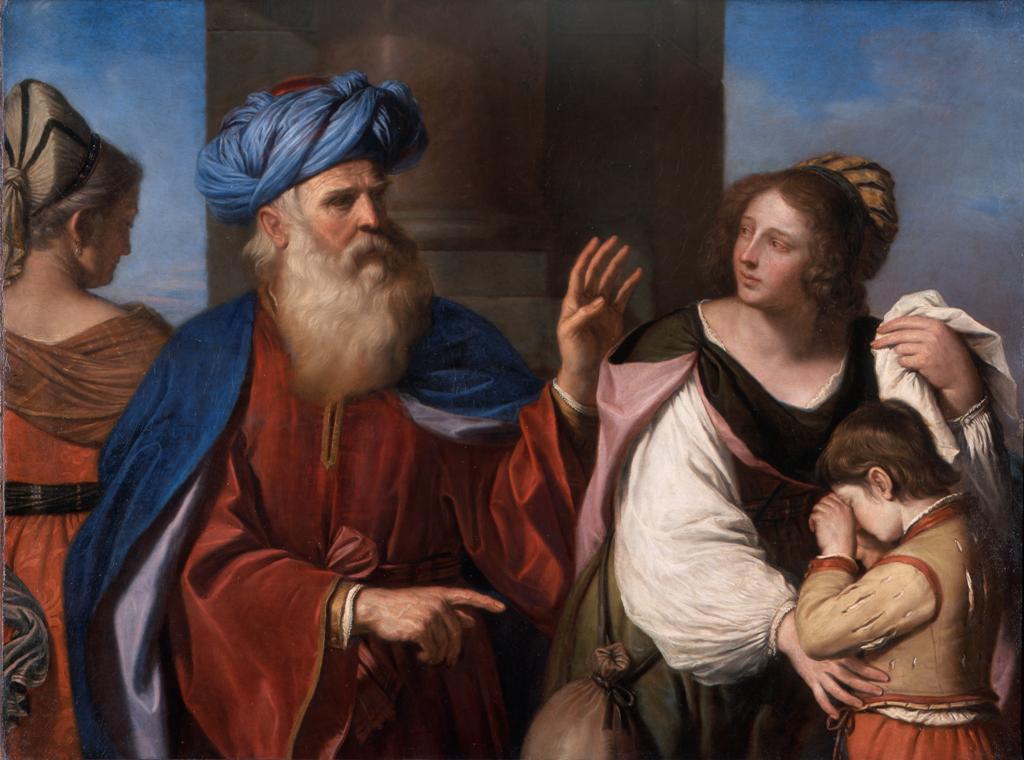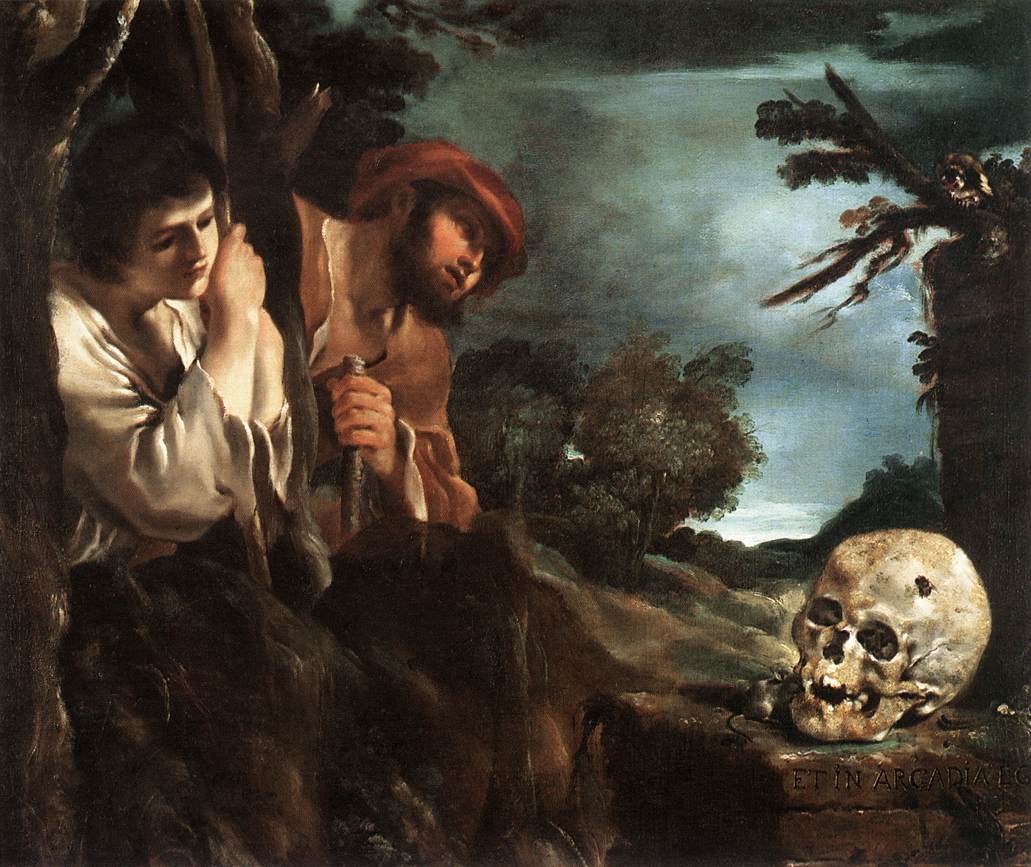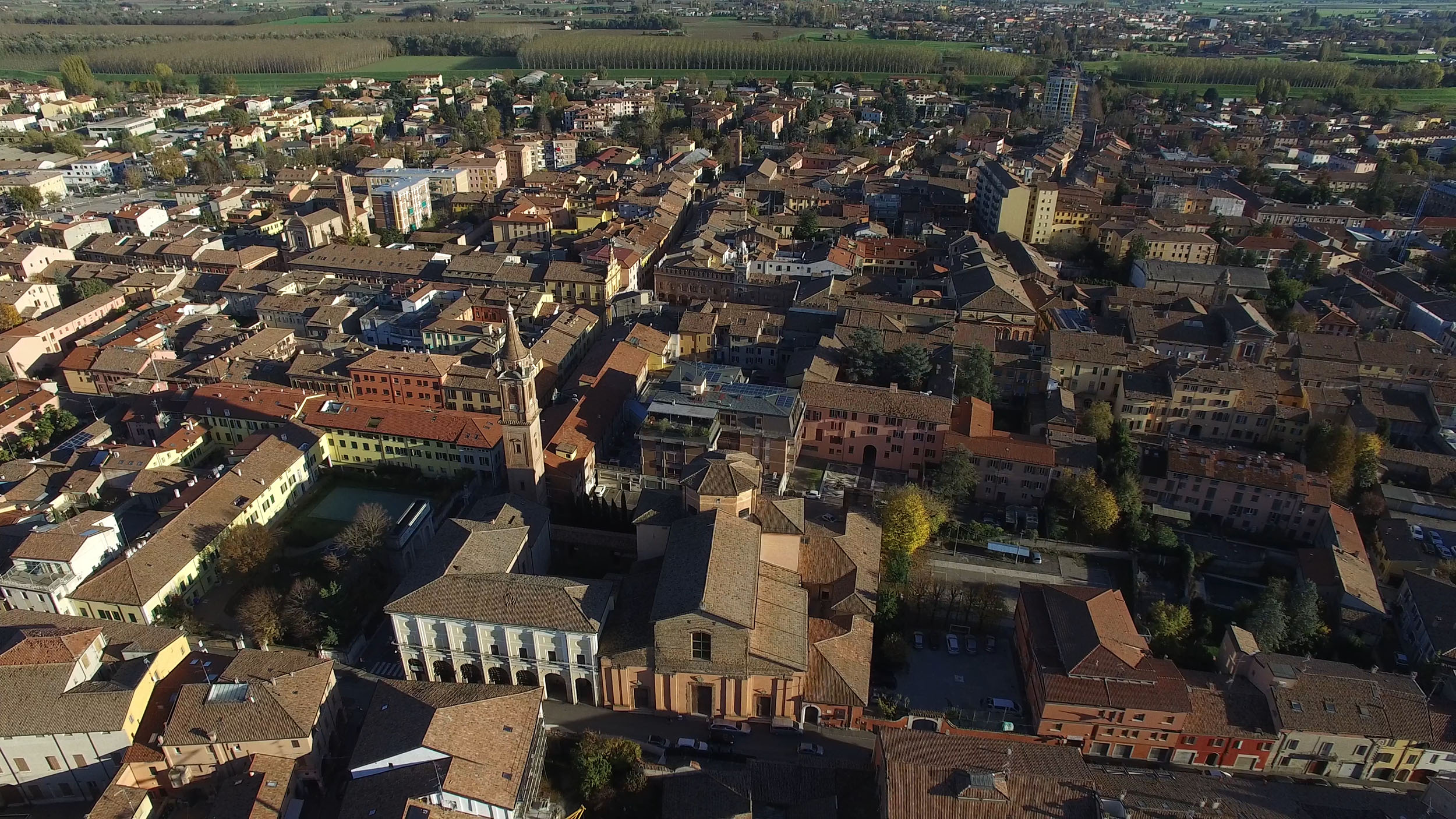|
Abraham Casting Out Hagar And Ishmael
''Abraham Casting out Hagar and Ishmael'' is a 1657 oil on canvas painting by Guercino, commissioned from him by the town of Cento to present to cardinal Lorenzo Imperiali, papal legate in Ferrara. It hangs now in the Pinacoteca di Brera in Milan. History and description The subject of the painting was taken from the Book of Genesis. It depicts the episode of the expulsion of Hagar and her son Ishmael by Abraham. According to the Genesis, Hagar was the slave of Sarah, Abraham's wife, and when he was 86 years old, she asked him to sleep with Hagar so that she could conceive a son. Fourteen years later, Sarah gave birth to a son, Isaac, to Abraham, who was 100 years old. Sarah ordered Abraham to send Hagar and Ishmael away, which he did, after being assured by God that it was done in accordance with His will. Guercino chose the moment when Abraham dismisses Hagar. All four characters are close to each other. Abraham is traditionally depicted with a beard and a turban. He is facing ... [...More Info...] [...Related Items...] OR: [Wikipedia] [Google] [Baidu] |
Guercino Abramo Ripudia Agar
Giovanni Francesco Barbieri (February 8, 1591 – December 22, 1666),Miller, 1964 better known as (il) Guercino (), was an Italian Baroque painter and draftsman from Cento in the Emilia-Romagna, Emilia region, who was active in Rome and Bologna. The vigorous naturalism of his early manner contrasts with the classical equilibrium of his later works. His many drawings are noted for their luminosity and lively style. Biography Giovanni Francesco Barbieri was born into a family of peasant farmers in Cento, a town in the Po Valley mid-way between Bologna and Ferrara.Mahon, 1937a Being Strabismus, cross-eyed, at an early age he acquired the nickname by which he is universally known, Guercino (a diminutive of the Italian noun , meaning 'squinter').Turner, 2003 Mainly self-taught, at the age of 16, he worked as apprentice in the shop of Benedetto Gennari, a painter of the Bolognese School (painting), Bolognese School. An early commission was for the decoration with frescoes (1615–1 ... [...More Info...] [...Related Items...] OR: [Wikipedia] [Google] [Baidu] |
Guercino
Giovanni Francesco Barbieri (February 8, 1591 – December 22, 1666),Miller, 1964 better known as (il) Guercino (), was an Italian Baroque painter and draftsman from Cento in the Emilia region, who was active in Rome and Bologna. The vigorous naturalism of his early manner contrasts with the classical equilibrium of his later works. His many drawings are noted for their luminosity and lively style. Biography Giovanni Francesco Barbieri was born into a family of peasant farmers in Cento, a town in the Po Valley mid-way between Bologna and Ferrara.Mahon, 1937a Being cross-eyed, at an early age he acquired the nickname by which he is universally known, Guercino (a diminutive of the Italian noun , meaning 'squinter').Turner, 2003 Mainly self-taught, at the age of 16, he worked as apprentice in the shop of Benedetto Gennari, a painter of the Bolognese School. An early commission was for the decoration with frescoes (1615–1616) of Casa Pannini in Cento, where the naturalis ... [...More Info...] [...Related Items...] OR: [Wikipedia] [Google] [Baidu] |
Cento
Cento (; Bolognese dialect, Northern Bolognese: ; Bolognese dialect, City Bolognese: ; Bolognese dialect, Centese: ) is a town and ''comune'' in the province of Ferrara, Emilia-Romagna, Italy. History The name Cento is a reference to the centuriation of the Po Valley. Cento's growth from its origin as a little fishing village in the marshes to an established farming town took place in the first few centuries in the second millennium. The Bishop of Bologna and the Abbot of Nonantola established the Partecipanza Agraria, an institution in which land would perpetually be redistributed every twenty years among the male heirs of the families who constituted the initial core of the community in the 12th century. In 1502, Pope Alexander VI took it away from the dominion of the Bishop of Bologna and made it part of the dowry of his daughter Lucrezia Borgia, betrothed to Duke Alfonso I d'Este. It was later returned to the Papal States in 1598. South-east of the city lies the small hist ... [...More Info...] [...Related Items...] OR: [Wikipedia] [Google] [Baidu] |
Lorenzo Imperiali
Lorenzo Imperiali (21 February 1612 - 21 September 1673) was an Italian Catholic cardinal. Early life Imperiali was born in Genoa on 21 February 1612 to the patrician Imperiali family of that city. He went to Rome during the pontificate of Pope Urban VIII and was appointed vice-legate in Bologna and governor of Fano and Ascoli Piceno. During the absence of Cardinal Antonio Barberini he was appointed legate in Ferrara. He was later appointed cleric of the Apostolic Chamber. During the Wars of Castro, Imperiali was appointed governor of those provinces of the State of Castro under the control of the papacy and was appointed commissary-general of the papal army. He was later sent by Pope Innocent X to Fermo to put down the uprising that had cost the life of its governor in 1648. Pope Innocent appointed Imperiali governor of Rome between 1653 and 1654. Ecclesiastic career Before appointing Imperiali governor, the pope elevated him to cardinal but the elevation was reserved ''in ... [...More Info...] [...Related Items...] OR: [Wikipedia] [Google] [Baidu] |
Papal Legate
300px, A woodcut showing Henry II of England greeting the Pope's legate. A papal legate or apostolic legate (from the ancient Roman title '' legatus'') is a personal representative of the Pope to foreign nations, to some other part of the Catholic Church, or to representatives of a state or monarchy. A legate is empowered in matters of Catholic faith and for the settlement of ecclesiastical matters. The legate is appointed directly by the Pope—the Bishop of Rome and head of the Catholic Church. Hence a legate is usually sent to a government, to a sovereign, to a large body of believers (such as a national church), or to take charge of a major religious effort, such as an ecumenical council, a crusade to the Holy Land, or even against a heresy such as the Cathars. The term ''legation'' is applied both to a legate's mandate and to the territory concerned (such as a state, or an ecclesiastical province). The relevant adjective is ''legatine''. History 200px, Cardinal Th ... [...More Info...] [...Related Items...] OR: [Wikipedia] [Google] [Baidu] |
Ferrara
Ferrara (; ; ) is a city and ''comune'' (municipality) in Emilia-Romagna, Northern Italy, capital of the province of Ferrara. it had 132,009 inhabitants. It is situated northeast of Bologna, on the Po di Volano, a branch channel of the main stream of the Po (river), Po River, located north. The town has broad streets and numerous palaces dating from the Renaissance, when it hosted the court of the House of Este. For its beauty and cultural importance, it has been designated by UNESCO as a World Heritage Site. History Antiquity and Middle Ages The first documented settlements in the area of the present-day Province of Ferrara date from the 6th century BC. The ruins of the Etruscan civilization, Etruscan town of Spina, established along the lagoons at the ancient mouth of Po river, were lost until modern times, when drainage schemes in the Valli di Comacchio marshes in 1922 first officially revealed a necropolis with over 4,000 tombs, evidence of a population centre that in ... [...More Info...] [...Related Items...] OR: [Wikipedia] [Google] [Baidu] |
Pinacoteca Di Brera
The Pinacoteca di Brera ("Brera Art Gallery") is the main public gallery for paintings in Milan, Italy. It contains one of the foremost collections of Italian paintings from the 13th to the 20th century, an outgrowth of the cultural program of the Brera Academy, which shares the site in the Palazzo Brera. History The Palazzo Brera owes its name to the Germanic ''braida'', indicating a grassy opening in the city structure: compare the ''Bra'' of Verona. The convent on the site passed to the Jesuits (1572), then underwent a radical rebuilding by Francesco Maria Richini (1627–28). When the Jesuits were disbanded in 1773, the palazzo remained the seat of the astronomical Observatory and the Braidense National Library founded by the Jesuits. In 1774 the herbarium of the new botanical garden was added. The buildings were extended to designs by Giuseppe Piermarini, who was appointed professor in the Academy when it was formally founded in 1776, with Giuseppe Parini as dean. ... [...More Info...] [...Related Items...] OR: [Wikipedia] [Google] [Baidu] |
Book Of Genesis
The Book of Genesis (from Greek language, Greek ; ; ) is the first book of the Hebrew Bible and the Christian Old Testament. Its Hebrew name is the same as its incipit, first word, (In the beginning (phrase), 'In the beginning'). Genesis purports to be an account of the Genesis creation narrative, creation of the world, the early history of humanity, and the Jews#Origins, origins of the Jewish people. In Judaism, the theological importance of Genesis centers on the covenants linking God in Judaism, God to his chosen people and the people to the Promised Land. Genesis is part of the Torah or Pentateuch, the first five books of the Bible. Tradition credits Moses as the Torah's author. However, there is scholarly consensus that the Book of Genesis was composed several centuries later, after the Babylonian captivity, Babylonian Babylonian captivity, captivity, possibly in the fifth century BC. Based on the scientific interpretation of Archaeology, archaeological, Genetics, genetic, ... [...More Info...] [...Related Items...] OR: [Wikipedia] [Google] [Baidu] |
Hagar
According to the Book of Genesis, Hagar is an Egyptian slave, a handmaiden of Sarah (then known as ''Sarai''), whom Sarah gave to her own husband Abram (later renamed Abraham) as a wife to bear him a child. Abraham's firstborn son, through Hagar, Ishmael, became the progenitor of the Ishmaelites, generally taken to be the Arabs. Various commentators have connected her to the Hagrites (sons of Agar), perhaps claiming her as their eponymous ancestor. Hagar is alluded to, although not named, in the Quran, and Islam considers her Abraham's second wife. Life Abraham and Hagar According to the Bible, Hagar was the Egyptian slave of Sarai, Abram's wife (whose names later became Sarah and Abraham). Sarai had been barren for a long time and sought a way to fulfill God's promise that Abram would be father of many nations, especially since they had grown old, so she offered Hagar to Abram to be his concubine. Hagar became pregnant, and tension arose between the two women. Genesis ... [...More Info...] [...Related Items...] OR: [Wikipedia] [Google] [Baidu] |
Ishmael
In the Bible, biblical Book of Genesis, Ishmael (; ; ; ) is the first son of Abraham. His mother was Hagar, the handmaiden of Abraham's wife Sarah. He died at the age of 137. Traditionally, he is seen as the ancestor of the Arabs. Within Islam, Ishmael is regarded as a Islamic prophets, prophet and the ancestor of the Ishmaelites (Hagarenes or Adnanites) and patriarch of Qaydār. Etymology The name "Yishma'el" existed in various ancient Semitic cultures, including early Babylonian and Minæan. In the Amorite language, it is attested as ''yaśmaʿ-ʾel''. It is a theophoric name translated literally as "El (god), God (El) has hearkened", suggesting that "a child so named was regarded as the fulfillment of a divine promise". Genesis narrative The Genesis narrative sees the account of Ishmael's life through the . Birth The birth of Ishmael was planned by the Patriarch Abraham's first wife, who at that time was known as Sarah, Sarai. She and her husband Abram (Abraham) sought ... [...More Info...] [...Related Items...] OR: [Wikipedia] [Google] [Baidu] |
Abraham
Abraham (originally Abram) is the common Hebrews, Hebrew Patriarchs (Bible), patriarch of the Abrahamic religions, including Judaism, Christianity, and Islam. In Judaism, he is the founding father who began the Covenant (biblical), covenantal relationship between the Jewish people and God in Judaism, God; in Christianity, he is the spiritual progenitor of all believers, whether Jewish or gentile, non-Jewish; and Abraham in Islam, in Islam, he is a link in the Prophets and messengers in Islam, chain of Islamic prophets that begins with Adam in Islam, Adam and culminates in Muhammad. Abraham is also revered in other Abrahamic religions such as the Baháʼí Faith and the Druze, Druze faith. The story of the life of Abraham, as told in the narrative of the Book of Genesis in the Hebrew Bible, revolves around the themes of posterity and land. He is said to have been called by God to leave the house of his father Terah and settle in the land of Canaan, which God now promises to Ab ... [...More Info...] [...Related Items...] OR: [Wikipedia] [Google] [Baidu] |
Isaac
Isaac ( ; ; ; ; ; ) is one of the three patriarchs (Bible), patriarchs of the Israelites and an important figure in the Abrahamic religions, including Judaism, Christianity, Islam, and the Baháʼí Faith. Isaac first appears in the Torah, in which he is the son of Abraham and Sarah, the father of Jacob and Esau, and the grandfather of the Twelve Tribes of Israel, twelve tribes of Israel. Isaac's name means "he will laugh", reflecting the laughter, in disbelief, of Abraham and Sarah, when told by God that they would have a child., He is the only patriarch whose name was not changed, and the only one who did not move out of Canaan. According to the narrative, he died aged 180, the longest-lived of the three patriarchs. Recent scholarship has discussed the possibility that Isaac could have originally been an ancestor from the Beersheba region who was venerated at a sanctuary. Etymology The anglicized name "Isaac" is a transliteration of the Hebrew language, Hebrew name () whic ... [...More Info...] [...Related Items...] OR: [Wikipedia] [Google] [Baidu] |









